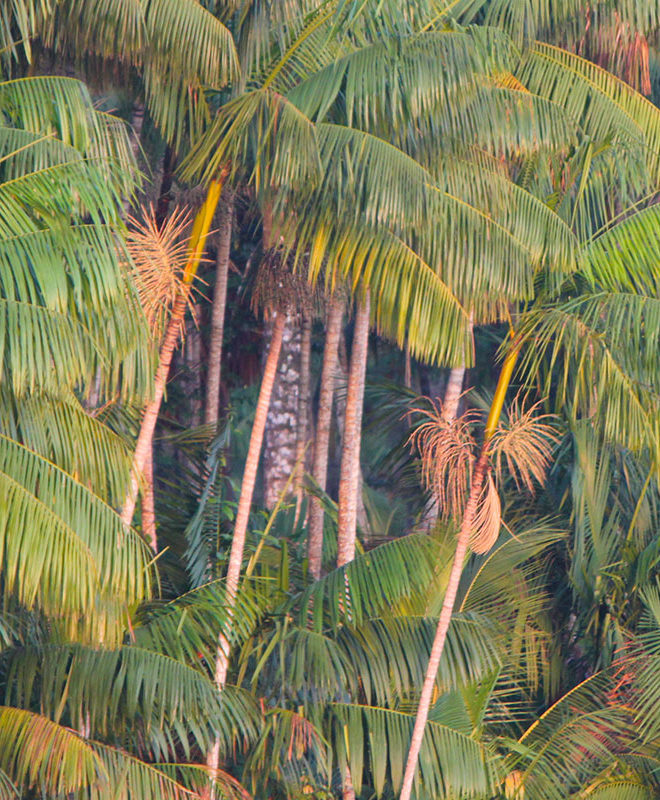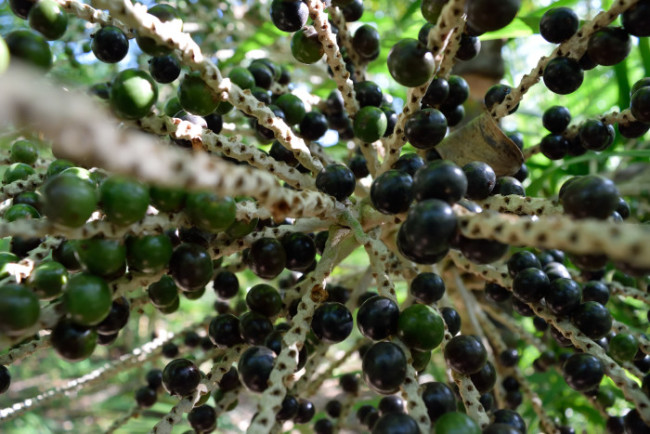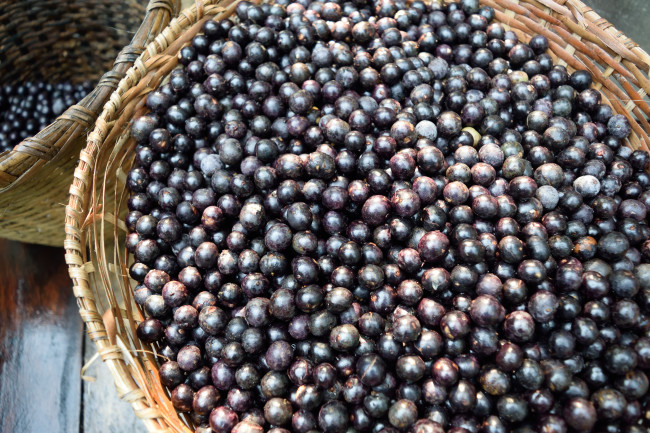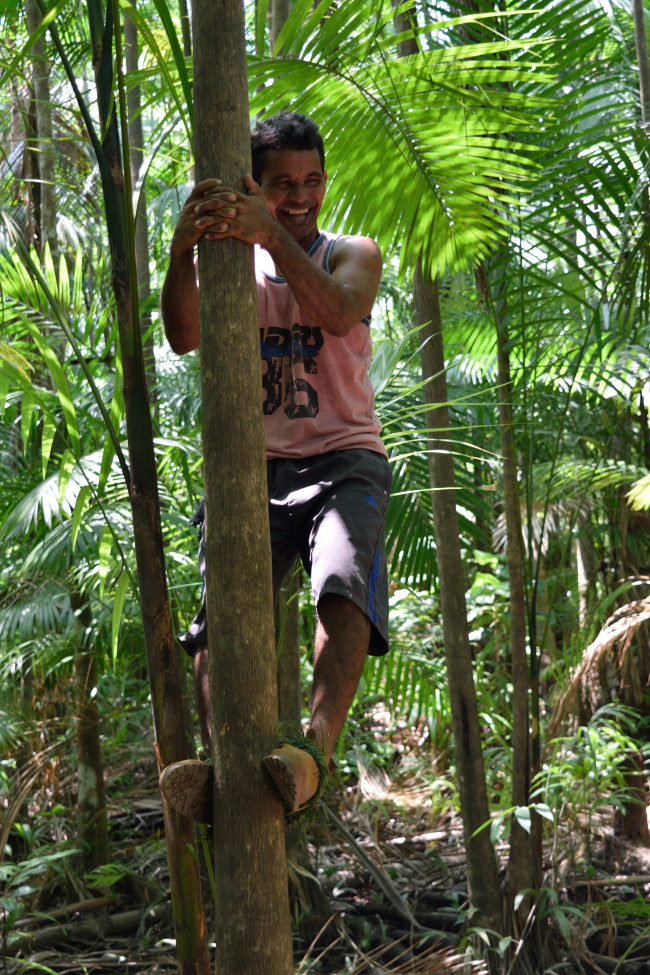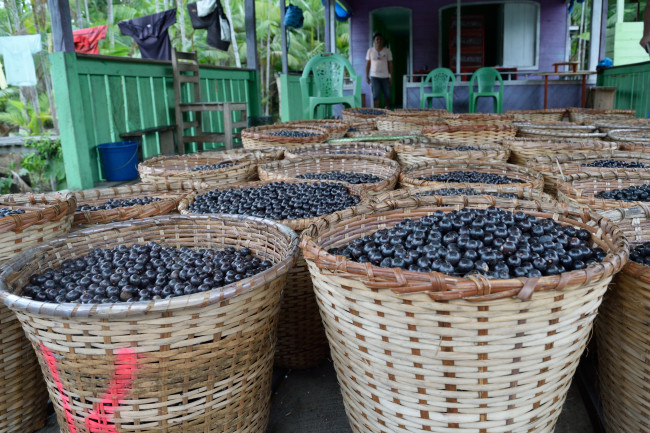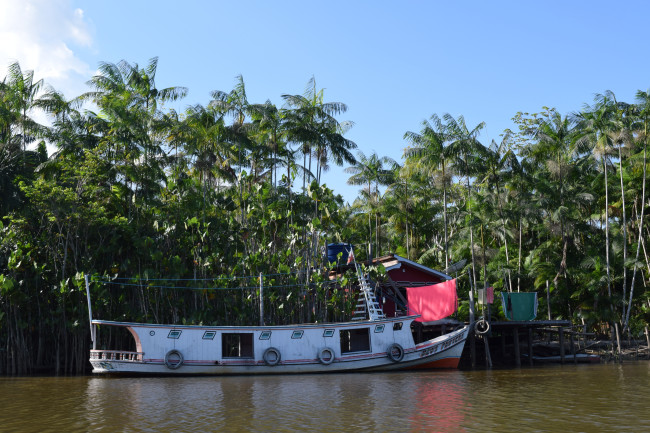Traditional Açaí: Understanding the Forests of the Amazon Estuary (Part 1)
We first met Leonora during our November 2015 trip to Brazil. As a Masters in Forestry candidate from Yale, she was living in Belem studying organic certification in acai agroforestry systems as part of her Fulbright Scholar program. She accompanied João (Director of Instituto Peabiru), our guide for the day, as we visited a small scale cacao farmer and specialty chocolate producer named Dona Nena, one of the beneficiaries of the Wild Honey Bee Project, a program directed by Peabiru, and supported in part by Tambor Acai and our 1% for The Planet donation. Of course there was plenty of time discuss acai sustainability in the Amazon. We asked her if she would write a series of articles sharing her knowledge of acai from an agroforestry perspective. She totally over delivered. Here is Leonora:
Traditional Açaí: Sustaining and Shaping the Forests of the Amazon Estuary (Part 1)
In this day and age, we hear a lot about the damages wreaked on the environment by conventional agriculture. The way we grow our food (and fibers and fuels) calls for the rampant use of agrotoxins, leads to the disappearance of topsoil, and in some places drives desertification and the loss of treecover and wildlife habitat.
A far cry from this dreary picture would be a system that produces an abundant, calorie- rich crop from within the shade of native equatorial rainforest; a system that is by definition organic; and one that is lucrative enough to provide the chief source of income to the rural population on a regional scale (1).
This system is not a theoretical dream of ecologists and rural development scholars. It exists, alive and well, in northern Brazil. The crop is açaí, the palm fruit native to the floodplain forest of the Amazon estuary.
THE AÇAÍ FOREST SYSTEM
In the space of a few decades, açaí has gone from having no market to speak of to becoming Brazil’s main forest food product by value (2). Growing, harvesting or transporting açaí is often the most profitable occupation available to people living in the rural communities of the estuary’s riverbanks and islands. This fact offers powerful motivation to keep large areas of forest standing.
Açaí’s marble-sized purple fruits grow in bunches that are harvested by hand, high above the ground, by forest farmers of the floodplain river communities. Native to the eastern Amazon, açaí grows well in forest managed to varying degrees. Traditional cultivation is “agro-extractive”: açaí is harvested from minimally managed forestland. On the more intensive end of the management spectrum, other tree species are cut out, allowing açaí to predominate.
Açaí is, however, just one of the many species that comprise the traditional mix of non- timber forest products grown in the estuary. Common crops also include fruit from other palms such as pupunha and meriti, plants used for fiber, oil from seeds such as andiroba and virola, and a profusion of fruits including cacau, cupuaçu, bananas, citrus, guava, papaya and mango.
THE AÇAÍ HARVEST
The height of açaí harvest season stretches over a three-month period each year. Beginning in July on the eastern side of the estuary, the small round fruits clustered on broom-like inflorescences at the top of each açaí stem begin to deepen to purple. By August, açaí harvest season is in full swing.
With their feet firmly on the ground in açaí groves (“açaizais” in the local lexicon), farmers are expert in assessing whether a particular bunch, high up in the subcanopy, has reached the optimum point of ripeness. This is a critical moment in determining the quality of the resulting pulp. Fruit with a lingering green tint won’t do. To deliver high quality and good flavor at pulping, the açaí at harvest has to be, in the words of countless farmers, “bem preto” (really black). Even more highly valued are the fruits that have progressed beyond the glossy purplish black to have an ashy “bloom” on their skin. This “açaí tuíra” is the choicest harvest.
The best time to bring in a harvest is in the early morning. During the high season, you’d be hard pressed to find anyone at home in the morning hours. All able-bodied family members take to the açaizais to help with the harvest, ascending the palms or waiting below to strip the fruit off of the bunches and into baskets. Families reemerge from the forest around ten or eleven in the morning, with twigs in their hair and purple stains on their hands from stripping the fruit.
The motivation for harvesting early is twofold. For one, açaí fruits have a higher moisture content in the morning before the sun reaches full strength; this makes for better quality. For another, after around 10:00 in the morning the palm stems heat up enough that a person harvesting at the treetop risks burning the arches of his or her bare feet from the friction of the descent.
During harvest season, river communities buzz with annual açaí festivals, and local ports function around the clock. Nights are no longer still, but filled with the percussive drone of outboard motors punctuated by sudden quiet when a motor cuts and a boat eases up to dock. These boats come heavily laden, gunwales resting unnervingly close to the surface of the water.
In dim electric light, dockworkers unload wicker baskets brimming with açaí. These handmade baskets are the standard transport container and unit of trade for açaí on the rivers. Their contents weigh in at approximately fourteen kilograms. Dockworkers transfer the açaí to crates and onto trucks that heave away toward local markets, nearby factories, or to the city of Castanhal where the marjority of Pará state’s açaí processing plants operates.
GROWING PAINS – THE GLOBAL MARKET FOR AÇAÍ
In recent years, açaí’s popularity around the world has skyrocketed. In the US it’s been billed as an antioxidant-rich superfood. You’re most likely to come across it in fruit juices, but more and more it’s also making appearances in chocolates, health supplements, and even cosmetics.
In many ways, açaí represents a possibility for agriculture of the future. At its best, cultivation is clean and ecologically sound. It’s anchored in regional culture and drives afforestation rather than deforestation (3). Biologically rich, multi-strata forest serves as a carbon sink while allowing those who manage the forest to derive significant income from it.
There are, however, notable ecological and socioeconomic issues associated with the expansion and intensification of açaí production. These issues may be growing pains from the rapid market growth or, less optimistically, groundwork for the next collapse in the Amazon’s history of boom and bust production cycles.
AÇAÍ ECOLOGY
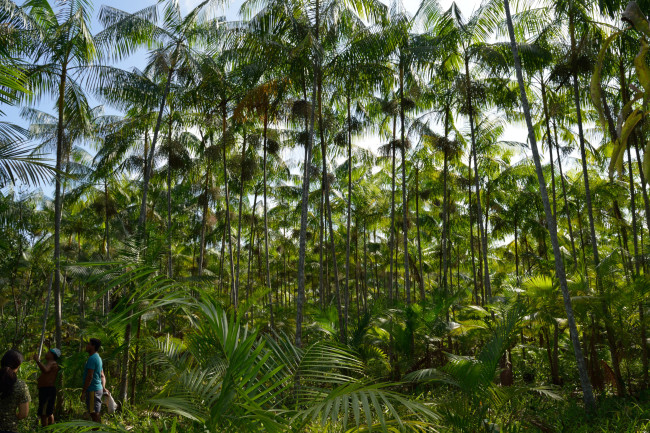
On the ecological side, there is the risk of forest biodiversity loss throughout the estuary’s floodplain forests. For forest farmers, açaí promises income that no other crop can currently match. Little by little, other tree species are cut or phased out to make way for new açaí seedlings. In some areas, parcels that were once mixed-species floodplain forest are now looking more and more like açaí monoculture. Since açaí cultivation is so ubiquitous, this increasing intensity presents a threat to forest diversity on a regional scale.
Some farmers are cognizant of the importance of retaining forest structure. An intact overstory provides shade down to the forest floor and habitat for wildlife. There are farmers who maintain that higher diversity is good for production—the resulting açaí has superior flavor and better yield once it’s pulped.
In the more diverse açaizais, the açaí palms fit seamlessly within a profusion of useful species—fruiting trees, trees for timber, for paddlemaking, for basketweaving—all quietly growing under sky-high canopies. Trees such as andiroba, murumuru and copaiba produce oil-rich seeds that are increasingly being used in industrial as well as artisan cosmetics and medicinals. In the cool, shady humidity stand ancient rubber trees, relics of the rubber boom, still carrying faintly repeating v-shaped scars on their trunks.
A downside of this ecologically rich approach to açaí cultivation is that the palm stems won’t produce fruit until they’re relatively taller. In the sunnier parcels with higher densities of açaí and fewer canopy trees to cast shade, fruit is produced starting when the crown is only a few meters above head height, making harvesting a much easier affair. Under a shady canopy, the resultingly taller stems present a heightened risk of falls during harvest.
EXPANDING PRODUCTION
Small-scale river farmers are not the only people investing in the açaí economy. As açaí production has become so lucrative, large landowners have taken note. Some erstwhile ranchers are converting cattle pasture to açaí cultivation.
This is a small shift away from an extremely detrimental land use system in the eastern Amazon. At the same time, these plantations are not your small-scale riverine forest production systems. Ranches are on land that ecologically speaking should be—and indeed once was—upland forest. Here our slender floodplain palm requires irrigation. Without daily flooding, upland cultivation also calls for synthetic agricultural inputs that are entirely absent from traditional açaí production. These plantations tend to be monocrops to boot, planted in tidy, easily mechanized rows.
Açaí currently forms the economic base of the rural population of the Amazon estuary. Traditional, forest-based production has the potential to support the integrity of floodplain forest cover on a regional scale. However, small-scale traditional farmers face stiff competition with the expansion of production beyond the floodplain.
Is there a difference in quality between floodplain- and plantation-grown açaí? Without a doubt. The continued viability of small-scale traditional production therefore rests largely upon recognizing and valuing a higher quality product. In order for the social, economic and environmental benefits of this production system to continue, tradition production must be set apart from the emerging agroindustrial enterprises.
FROM THE AMAZON TO THE WORLD
As the popularity of açaí persists and grows, consumers in the US and other countries should realize that not all açaí is equal. As we do, will there be an emergence of specialty and craft açaí products, as we’ve seen with coffee and chocolate? Some day soon, will we have the option to choose among single-origin, certified fair trade, specialty varietal, wildlife friendly açaí products at our grocery stores? Will importers be able to harness social awareness in the market to garner a premium for açaí sourced directly from producers’ cooperatives or through partnerships with conscientious local processing plants?
For their part, forest farmers continue to innovate. In some communities, producers are forming cooperatives in order to market collectively, thus vying to increase their bargaining power and, in some cases, sell directly to international buyers. Some are looking toward certification programs as a tool to add value to their high-quality product.
These strategies have the potential to help small-scale forest farmers to stay in the race. What’s at stake is their endurance as açaí producers, as well as their ability to extract profit through ecologically sound forest management without being obliged to shift toward more intensive production systems. The extent to which they succeed will have profound effects on the future of the forests and communities of the Amazon estuary.
—
About Leonora Pepper
Leonora Pepper is currently pursuing a Master of Forestry degree at Yale University’s School of Forestry & Environmental Studies. In 2015, as a U.S. Fulbright Scholar Leonora spent nine months in northern Brazil studying traditional açaí production in riverine communities of the Amazon estuary region. With the support of local collaborators at the Federal University of Pará and Peabiru Institute, she investigated how small-scale forest-grown açaí fits within the growing global market, as well as approaches to certification best suited to the traditional production model.
Leonora holds a Bachelor of Arts in Economics from Smith College. When not in school or in the field, Leonora enjoys long-distance bicycling and teaching her dog to untie knots.
—
Citations
1. Brondizio, Eduardo S. 2008. The Amazonian Caboclo and the Açaí Palm: Forest Farmers in the Global Market. Edited by Charles M. Peters. Bronx, New York: The New York Botanical Garden Press.
2. IBGE, Diretoria de Pesquisas, Coordenação de Agropecuária, Produção da Extração Vegetal e da Silvicultura 2011, 12, 13.
3. Brondizio, Eduardo S. 2008. The Amazonian Caboclo and the Açaí Palm: Forest Farmers in the Global Market. Edited by Charles M. Peters. Bronx, New York: The New York Botanical Garden Press.

